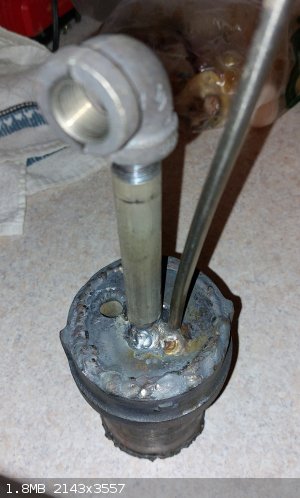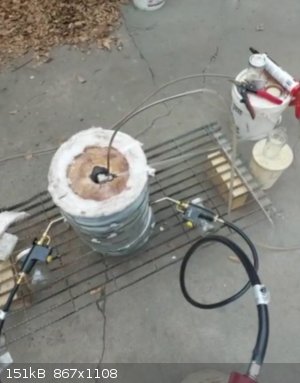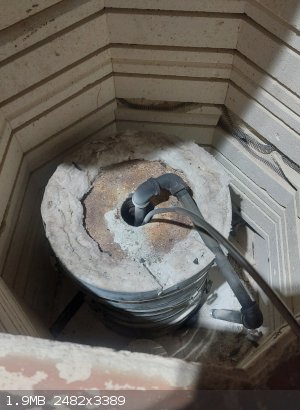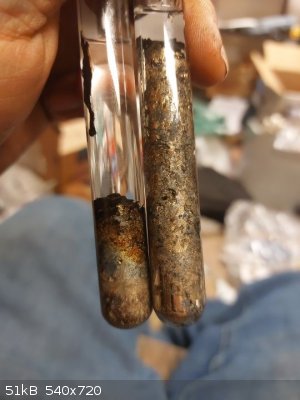kilowatt
Hazard to Others
  
Posts: 322
Registered: 11-10-2007
Location: Montana
Member Is Offline
Mood: nitric
|
|
Cesium Reduction/Distillation
I have been doing this process in a small steel retort with an argon feed tube, a thermocouple well, and a column out the top going to a condenser and
into a collection jar of kerosene.
Ca(s or l) + 2CsCl (l) = CaCl2 (l) + 2 Cs(g)
My first attempt used 250g of CsCl and 30g or so of calcium. I used an 8mm ID fused quartz condenser for this run. When the cesium started to come
over, I thought I was seeing just some vapor lining the inside of the condenser. What was really going on though was that the condenser was totally
plugged with cesium. The cesium forced its way out through my thread seal, and some or all was lost. I ended up collecting just 6g of cesium out of
the condenser. The pressure in the retort drove molten salt up the argon feed tube, permanently plugging it and rendering the retort basically
useless.
My second attempt used the same retort and setup without removing any material. I added 125g of CsCl, and about 30g of Ca again I'm case any CsCl
remained from the first attempt to react with. Since the argon feed was plugged I tried adding a little kerosene into the retort to displace air. It
wasn't enough and a bunch of air got sucked into the retort when the calcium got hot. The kerosene was pulsing up the condenser from the collection
jar and I was worried this could be bad, so I removed the collection jar a few times. Eventually I just let it either sort itself out or blow up, and
I yielded 14g of cesium. I was not surprised since most of the calcium got burned up. This time I kept a torch on the condenser to keep it from
freezing.
My third attempt I thought I had everything figured out from the previous attempts. I built a new but mostly identical retort, and placed the whole
setup in my kiln to maintain an ambient temperature enough to keep the cesium from freezing. I used 125g of CsCl and 18g of Ca, a slight excess. I
used a more powerful modulating propane burner rather than the simple torches of before, able to hit temp faster and better. I used a safer and more
robust steel condenser and stainless steel collection jar. I did the run and got basically no cesium, or maybe just a couple grams. I did not have
temperature measurement of the retort during the run this time because the thermocouple and temp control was used running the kiln, but I ramped it up
as slowly as practical and went until I knew by color I was way over temp. Taking the measurement after shutdown this was upwards of 1000°C.
I am at a loss after this last attempt. I did not learn anything that I can do better next time, because I do not know what went wrong. I feel like I
am not going to be able to do any more successful runs now.
Also I am in the process of recovering CsCl from the previous attempts. I have the contents of the first retort in solution and decanted off from the
calcium hydroxide. I am planning on using ammonia to precipitate the calcium from chloride, and then I can drive off the ammonium chloride under heat.
This should yield mostly CsCl which I can reuse. Would this work?
   
[Edited on 13-12-2021 by kilowatt]
[Edited on 13-12-2021 by kilowatt]
The mind cannot decide the truth; it can only find the truth.
|
|
|
j_sum1
Administrator
       
Posts: 6219
Registered: 4-10-2014
Location: Unmoved
Member Is Online
Mood: Organised
|
|
Cody of codyslab came up with a rather nice setup for distilling alkali metals. I have not tried it, but it looks like a goid idea snd he has
demonstrated uts effectiveness several times. I will see if i can find a link.
|
|
|
metalresearcher
National Hazard
   
Posts: 731
Registered: 7-9-2010
Member Is Offline
Mood: Reactive
|
|
Try with CsCl and Li metal. I tried this successfully making potassium with Li metal and KCl heating to 800 C. Cody's lab did this successfully with
CsCl + Li. As long as the retort is above the boiling point of Cs (680 C) it wil work.
|
|
|
fredsci93
Hazard to Self
 
Posts: 84
Registered: 29-12-2017
Member Is Offline
Mood: No Mood
|
|
this? https://www.youtube.com/watch?v=Ymgu_LaDrN0
|
|
|
kilowatt
Hazard to Others
  
Posts: 322
Registered: 11-10-2007
Location: Montana
Member Is Offline
Mood: nitric
|
|
I've seen the Codyslab video on cesium before. It's what made me think I could try this at home. I'm sure lithium is great but I have read that in
industry they use calcium. Calcium is cheaper for me, $2.70 per mole of alkali metal vs $3.50 per mole for lithium. This could get even cheaper if I
extracted my own calcium, where lithium does not get any cheaper. This could be important if I wanted to scale up and make cheap potassium. Also I
already proved that calcium does reduce cesium.
Also Cody had a failure using lithium in his big retort due to some kind of boil over. He abandoned that retort entirely and we never got to see it
work.
I am trying to come up with theories on why my last run failed. Whatever happened may happen with lithium too. The only practical difference I can
think of is that lithium has a lower melting oxide that is probably more soluble in the chlorides. Also lithium is not soluble in cesium metal or any
chlorides where calcium is soluble in CaCl2.
The mind cannot decide the truth; it can only find the truth.
|
|
|
walruslover69
Hazard to Others
  
Posts: 216
Registered: 21-12-2017
Member Is Offline
Mood: No Mood
|
|
During your last run, where you achieved a low yield. What was the composition of the material remaining in the retort? Was the unreacted calcium
metal and CsCl2 still present? or did you have cesium metal escape?
|
|
|
kilowatt
Hazard to Others
  
Posts: 322
Registered: 11-10-2007
Location: Montana
Member Is Offline
Mood: nitric
|
|
I have not gotten the material out of the retort yet. Might start that process tonight. I should know right away if there is unreacted calcium, or I
might not because as the retort cooled overnight it would have sucked in air. I will have to separate and evaporate down before I know how much cesium
is left in there. I am pretty sure no cesium escaped in any form, or I would have seen smoke or salt fume flame testing positive for cesium, which I
did not. During my first run I did see the smoke of escaping cesium when my condenser was plugged.
Edit: I just filled the second (from my last run) retort with water. There was no reaction. This is unlike the first retort, which contained a
considerable amount of calcium nitride. Further analysis will begin once the contents are dissolved.
[Edited on 14-12-2021 by kilowatt]
The mind cannot decide the truth; it can only find the truth.
|
|
|